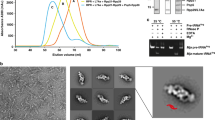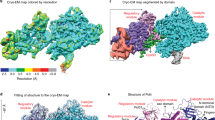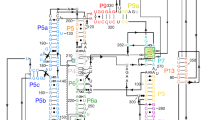Abstract
BACTERIAL DNA-dependent RNA polymerase (nucleoside triphosphate–RNA nucleotidyltransferase; EC 2.7.7.6) consists of at least four different subunits (α, β, β′, and σ) and the subunit composition of the holo-and core enzymes are α2ββ′σ- and α2ββ′, respectively. These subunits play different roles and the overall reaction catalysed by this enzyme is well organised and highly specific. To understand the mechanism of transcription, a precise knowledge of the structure of this enzyme is indispensable. The structure of RNA polymerase has been studied by small-angle X-ray analysis1 and electron microscopy2–6. Data obtained using these methods, however, are not satisfactory, and even contradict each other. X-ray crystallography seems to be7,8 the most powerful method of analysing the three-dimensional structure of proteins. Since RNA polymerase has not yet been crystallised, however, it has been impossible to apply this technique. We have recently isolated the core enzymes and holoenzymes of RNA polymerase from the thermophilic bacterium, Thermus thermophilus HB 8 (ref. 9). Both enzymes are quite stable not only against heating but also against denaturation by various detergents. One of the reasons why crystallisation of RNA polymerase has not yet been achieved in spite of many publications concerning extensive purification of the enzyme from various sources, is probably the instability of the enzyme. As a first step towards X-ray crystallographic analysis of RNA polymerase, we tried to crystallise the thermophilic core enzymes and holoenzymes in the hope that their extreme stability might help the crystallisation of the enzyme. We have succeeded in crystallising the core enzyme but not the holoenzyme.
This is a preview of subscription content, access via your institution
Access options
Subscribe to this journal
Receive 51 print issues and online access
$199.00 per year
only $3.90 per issue
Buy this article
- Purchase on Springer Link
- Instant access to full article PDF
Prices may be subject to local taxes which are calculated during checkout
Similar content being viewed by others
References
Pilz, I., Kratky, O., and Raubussay, D., Eur. J. Biochem., 28, 205–220 (1972).
Fuchs, E., Zillig, W., Hofschneider, P. H., and Preuss, A., J. molec. Biol., 10, 546–550 (1964).
Colvill, A. J. E., Bruggen, E. F. J. Van, and Fernandez-Moran, H., J. molec. Biol., 17, 302–304 (1966).
Slayter, H. S., and Hall, C. E., J. molec. Biol., 21, 113–114 (1966).
Kitano, Y., and Kameyama, T., J. Biochem., 65, 1–16 (1969).
Lubin, M., J. molec. Biol., 39, 219–233 (1969).
Dickerson, R. E., A. Rev. Biochem., 41, 815–842 (1972).
Liljas, A., and Rossman, M. G., A. Rev. Biochem., 43, 475–507 (1974).
Date, T., and Suzuki, K., and Imahori, K., J. Biochem., 78, 845–858 (1975).
Weber, K., and Osborn, M., J. Biol. Chem., 244, 4406–4412 (1969).
Kalckar, H. M., J. Biol. Chem., 167, 461–475 (1947).
Author information
Authors and Affiliations
Rights and permissions
About this article
Cite this article
TSUJI, S., SUZUKI, K. & IMAHORI, K. Crystallisation of DNA-dependent RNA polymerase from Thermus thermophilus HB 8. Nature 261, 725–726 (1976). https://doi.org/10.1038/261725a0
Received:
Accepted:
Published:
Issue Date:
DOI: https://doi.org/10.1038/261725a0
Comments
By submitting a comment you agree to abide by our Terms and Community Guidelines. If you find something abusive or that does not comply with our terms or guidelines please flag it as inappropriate.



